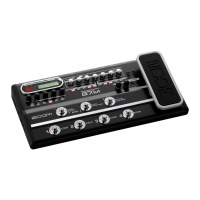
Do you have a question about the Zoom G7.1ut and is the answer not in the manual?
| Type | Multi-Effects Processor |
|---|---|
| Looper | Yes |
| Display | LCD |
| Sampling Rate | 44.1 kHz |
| Bit Depth | 24-bit |
| USB | Yes |
| Expression Pedal | Yes |
| Simultaneous Effects | 9 |
| Effect Types | Delay, Reverb, EQ, Modulation, Distortion |
| Inputs | 1 x Aux |
| Outputs | 2 x 1/4" (L/Mono, R) |
| Power Supply | AC Adapter |
General precautions for safe and proper operation of the G7.1ut.
Identifies and describes the controls and sections on the top panel of the G7.1ut.
Identifies and describes the connectors and controls on the rear panel of the G7.1ut.
Illustrates how to connect the G7.1ut to a guitar amplifier for basic use.
Explains how to select and switch between patches in play mode.
Details how to use foot switches to control effect modules in manual mode.
Instructions on how to modify effect parameters within a patch using edit mode.
Explains the process of saving edited patches and their settings.
Step-by-step guide on how to select patches using foot switches and parameter knobs.
How to adjust pre-amp parameters like distortion type, EQ, and level in play mode.
How to activate or deactivate effect modules using foot switches in manual mode.
Step-by-step guide to using the chromatic tuner function.
General steps for editing patches in edit mode.
Specifics on editing PRE-AMP/EQ modules using the pre-amp section controls.
Instructions for editing modules other than PRE-AMP/EQ using the TYPE knob and parameter knobs.
How to display the patch name for editing.
Detailed steps for saving or swapping individual patches.
How to reset user patches to their original factory settings.
How to assign parameters to the expression pedal for real-time control.
Procedure for calibrating or adjusting the built-in expression pedal's sensitivity.
How to choose a function for the foot switch.
How to set the MIDI channel for communication.
How to enable MIDI program change send/receive functionality.
How to assign control change numbers to specific functions.
Explains the Auto-Repeat Real-time Modulation (ARRM) feature.
How to optimize sound for different guitar amplifiers.
How to alter the signal chain order of effect modules.
Guide on interpreting the effect parameter tables.
Details on the Compressor effect module and its parameters.
Details on the ZOOM Noise Reduction module.
Details on the PRE AMP module, its effect types, and parameters.
Details on the Equalizer module and its parameters.
Details on the CABINET module and its parameters.
Details on the Modulation/EFX2 module and its parameters.
Description of the Bend Chorus effect and its parameters.
Details on the Delay module and its various effect types.
How to name the current patch.
Parameter for specifying the first expression pedal control target.
Parameter for specifying the second expression pedal control target.
Chart detailing MIDI messages transmitted and recognized by the G7.1ut.
List of preset patches categorized under the DEMO section.
List of preset patches categorized under the MODELING section.
List of patches inspired by various artists.
Recommended amp settings for popular guitar amplifier models.
Description of the Fender Twin Reverb '65 amp model.
Description of the VOX AC30TBX (Clean) amp model.
Description of the Roland JAZZ CHORUS amp model.
Description of the MESA/BOOGIE Dual Rectifier amp model.
Instructions for installing the Cubase LE software.
Steps to connect the G7.1ut to a computer for Cubase LE.
Configuring settings for a new audio track within Cubase LE.
Connecting the G7.1ut to a computer for Cubase LE 4.
Guide on using Cubase LE 4 for recording audio.
Confirming the USB audio driver is active in Cubase LE.